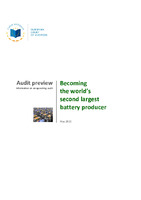| dc.contributor.author | European court of auditors |
| dc.date.accessioned | 2023-06-19T14:04:40Z |
| dc.date.available | 2023-06-19T14:04:40Z |
| dc.date.issued | 2022-05 |
| dc.identifier.uri | https://ketlib.lib.unipi.gr/xmlui/handle/ket/3953 |
| dc.description | Audit preview Information on an upcoming audit |
| dc.description | If you wish to contact the audit team, send an e-mail to the following address: ECA-Audit_Previews@eca.europa.eu |
| dc.description | Cover page: Adobe Stock / 321408657 |
| dc.description.abstract | Transport accounts for around a quarter of the EU’s greenhouse gas emissions. If the
EU is to achieve climate neutrality, it will need to reduce its transport-related
emissions by 90 % by 2050. Among other measures, meeting this goal will require a
massive uptake of zero and low-emission vehicles: 13 million cars by 20251, 30 million
by 20302, and potentially a ban on sales of new combustion engine vehicles
from 20353.
In this context, the Commission has designated battery development and production
as a strategic imperative for Europe. Investing in battery production will support the
EU’s efforts to achieve a clean energy transition, including by allowing intermittent
renewable energy to be stored for later use. Advances in battery technology and
production will be a key contributor to the competitiveness of the EU’s automotive
sector4. Investments in the EU’s battery value chain will also address Europe’s current
strategic dependence on foreign batteries. |
| dc.format.extent | 9p. |
| dc.language.iso | en |
| dc.publisher | Publications Office of the European Union |
| dc.subject | Policy framework |
| dc.subject | Strategic Action Plan on Batteries |
| dc.subject | Regulation |
| dc.title | Becoming the world’s second largest battery producer |
| dc.type | Audit preview |
| dc.publisher.place | Luxembourg |

